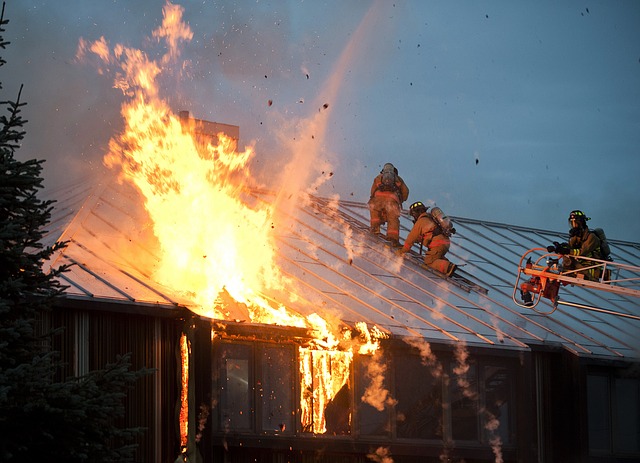Developing test methods to assess video flame and video smoke detectors

|
Contents |
[edit] Introduction
Video fire detectors emerged as a new means of fire detection around 2004, particularly in large indoor spaces such as those in atria, warehouses and industrial complexes. Detection of fires in such spaces has traditionally been provided by optical-beam smoke and aspirating smoke detectors, or flame detectors – but video fire detectors potentially offer important advantages.
[edit] They can ‘see’ the fire
A video detector is alerted to the presence of a fire by identifying the characteristic signatures of smoke or flame within the field of view of its camera. The images from the live video feed are analysed by sophisticated algorithms to detect these signatures. There are two detector types – video flame detectors (VFDs) that recognise flaming fires, and video smoke detectors (VSDs) that are alerted to the presence of moving smoke. Some systems can have both sets of algorithms working independently at the same time.
The detector does not need to be in proximity to smoke or flames to detect fire as (provided there is direct line of sight) it can ‘see’ them. This enables a quicker response than is generally achievable by conventional smoke and flame detectors, and can also provide a visual verification of fire.
[edit] No current means of testing/assessing capabilities
While there has been a significant amount of fundamental research work on the capabilities and potential applications of video fire detectors, due to their complexity there are currently no defined and robust methods of assessing the capabilities of these detectors for testing and certification purposes.
Work by BRE Global and the Fire Industry Association (FIA) to develop test methodologies for these technologies has identified the greatest obstacle to be a lack of benchmark tests of basic performance. These are needed to perform the fundamental tests of repeatability, reproducibility and environmental testing defined in the EN 54 Fire detection and fire alarm systems standard. Additionally, operational performance tests are needed to verify the absolute capabilities of video detectors in detecting the fires anticipated in service environments.
A BRE Trust-supported research programme was established by BRE, in collaboration with video fire detector manufacturers, to develop benchmark and operational performance test methods for both video flame and video smoke detectors. To gain the necessary underpinning knowledge on the performance capabilities of video fire detectors, the research group has developed methods for bench testing and full-scale fire testing of these systems.
[edit] Collaborative research programme
The group’s development of methodologies for assessing the performance of VFDs and VSDs has been summarised in a briefing paper that can be freely downloaded from here. It is now expected that these methodologies will support the development of a test standard and associated code of practice.
[edit] About this article
This article was written by the BRE Trust and published in July 2019 on its website under the title ‘Video flame and smoke detectors’. It can be accessed here.
Other articles by BRE on Designing Buildings Wiki can be accessed here.
[edit] Related articles on Designing Buildings Wiki
Featured articles and news
RTPI leader to become new CIOB Chief Executive Officer
Dr Victoria Hills MRTPI, FICE to take over after Caroline Gumble’s departure.
Social and affordable housing, a long term plan for delivery
The “Delivering a Decade of Renewal for Social and Affordable Housing” strategy sets out future path.
A change to adoptive architecture
Effects of global weather warming on architectural detailing, material choice and human interaction.
The proposed publicly owned and backed subsidiary of Homes England, to facilitate new homes.
How big is the problem and what can we do to mitigate the effects?
Overheating guidance and tools for building designers
A number of cool guides to help with the heat.
The UK's Modern Industrial Strategy: A 10 year plan
Previous consultation criticism, current key elements and general support with some persisting reservations.
Building Safety Regulator reforms
New roles, new staff and a new fast track service pave the way for a single construction regulator.
Architectural Technologist CPDs and Communications
CIAT CPD… and how you can do it!
Cooling centres and cool spaces
Managing extreme heat in cities by directing the public to places for heat stress relief and water sources.
Winter gardens: A brief history and warm variations
Extending the season with glass in different forms and terms.
Restoring Great Yarmouth's Winter Gardens
Transforming one of the least sustainable constructions imaginable.
Construction Skills Mission Board launch sector drive
Newly formed government and industry collaboration set strategy for recruiting an additional 100,000 construction workers a year.
New Architects Code comes into effect in September 2025
ARB Architects Code of Conduct and Practice available with ongoing consultation regarding guidance.
Welsh Skills Body (Medr) launches ambitious plan
The new skills body brings together funding and regulation of tertiary education and research for the devolved nation.
Paul Gandy FCIOB announced as next CIOB President
Former Tilbury Douglas CEO takes helm.
UK Infrastructure: A 10 Year Strategy. In brief with reactions
With the National Infrastructure and Service Transformation Authority (NISTA).























